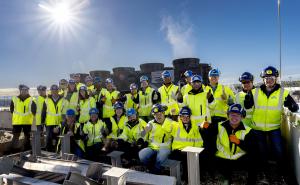White "smoke" brings good news
Like a plume of white smoke rising from a cardinals' conclave to announce the election of a new pope, the tenuous vapour coming from one of the ITER cooling cells brings good news to the project. The white "smoke" (which is not smoke at all, but water vapor), indicates that the helium compressors inside the cryoplant are running and that the heat they generate is being properly evacuated by the interconnected cooling water and heat rejection systems.
Of the 18 megawatt-class compressors tasked to deliver gaseous helium to the cold boxes, only a few are currently being tested. In the coming weeks, more will come on line and a peak 25 MW of heat will be evacuated.
The vapour plume marks an important moment in the journey that brought together the ITER Organization, ITER India and industrial partners, and that began in 2016 with the final design review for the cooling water system. This important system, once fully operational, will be capable of extracting up to 1,200 MW (peak) of heat generated by the installation's industrial infrastructure and plasma experiments.
The ITER cooling water and heat rejection systems recently entered routine operation and are now ready to support the plant system processes that require continuous water cooling for their commissioning.
It is an important step celebrated by all those who had a part in the challenge. "We are proud today to share the success story of moving from an engineering model to reality," explain Pierre Yves Tavennec and Thomas Pralus, ITER cooling water system commissioning engineers.
"The way to the cryoplant operational acceptance testing phase is now open," says David Grillot, deputy head of the ITER Plant System Program. "The goal will be to demonstrate that the refrigeration system that feeds cooling fluids to the clients inside the tokamak will reach performance requirements."
Cryogenic cooling fluid production will begin as early as next year in service of both the magnet cold test facility and the smaller cryopump test facility, whose main elements are already in place in the cryoplant.


